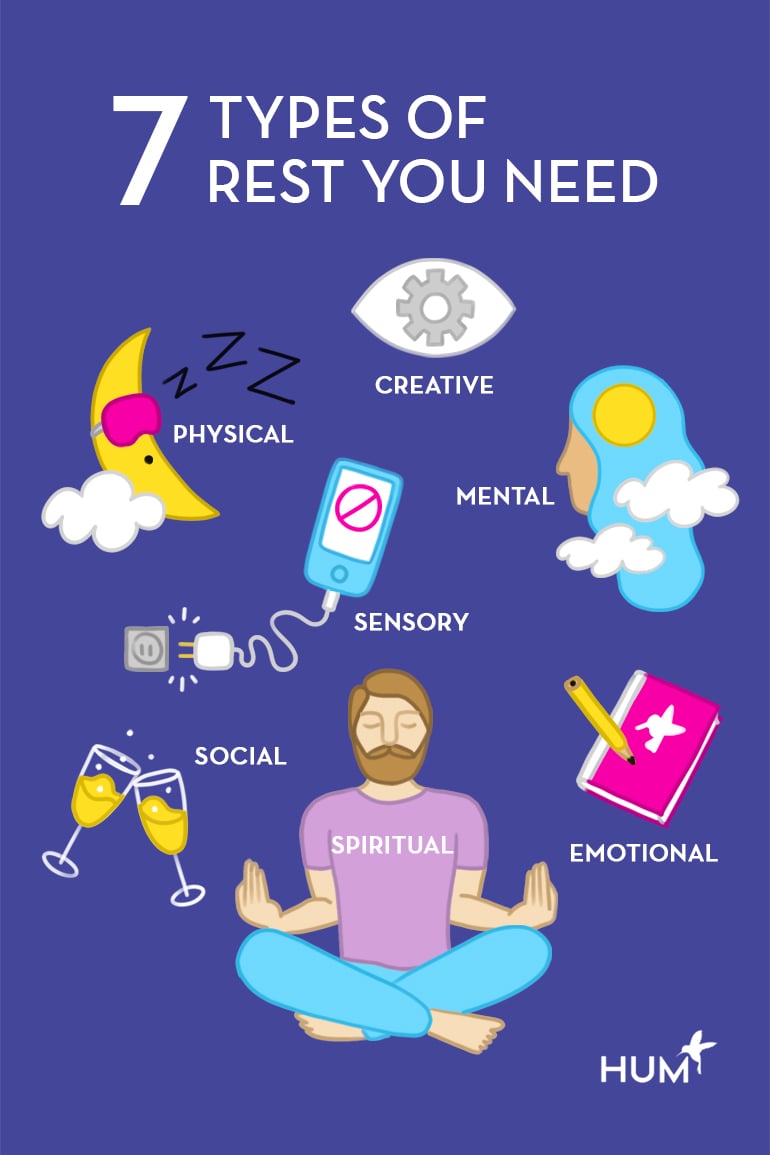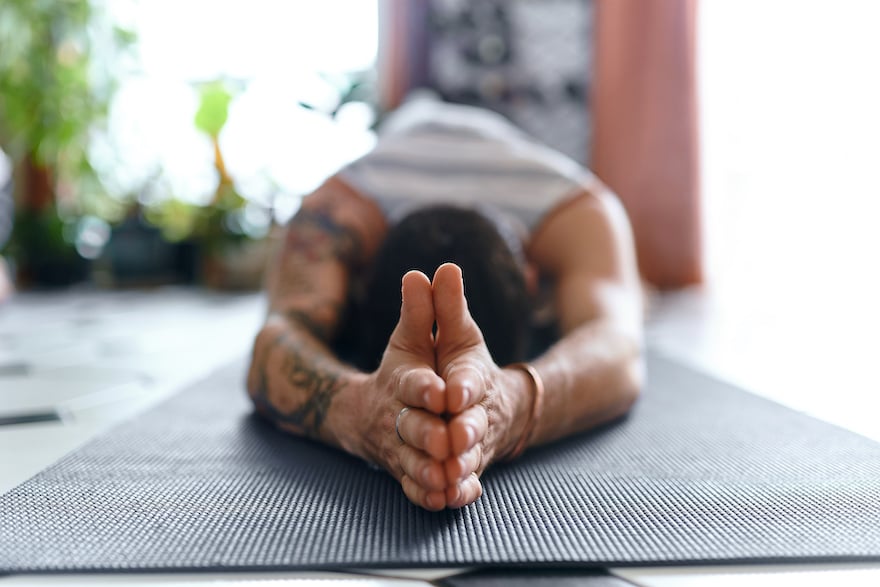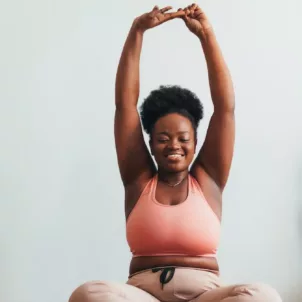Burnout and stress are more prevalent than ever, according to the American Psychological Association. But there is a way to fight these mental health conditions: rest (and no, that doesn’t just mean sleep). Below, we break down the seven different types of rest you should be getting—other than snoozing.
Have you ever made it a point to get seven to nine hours of sleep—the recommended time for adults, according to the National Sleep Foundation—only to still feel exhausted once your alarm rings? As it turns out, a lack of sleep might not be your issue—a lack of rest could be.
In 2019, board-certified internal medicine physician Saundra Dalton-Smith, MD did a TED Talk about the importance of rest. The concept? Sleep is essential for survival, but rest—conscious relaxation—is, too.
The Importance of Rest

We all know what it’s like to feel well-rested—awake, grounded, centered, and ready to take on whatever comes our way. Unfortunately, in today’s capitalist society, making time for rest is often a second thought.
“Rest is vital for optimal health and well-being, [however,] rest is often viewed as something not valuable because work is not being completed—productivity is not being accomplished,” explains research neuroscientist Nicole Avena, PhD. Yet without adequate rest, it’s impossible to work effectively, which makes it more difficult to be productive. As such, Dr. Avena points out that rest—not just sleep—is the key to avoiding burnout.
“In today’s society, it is extremely common to work long hours and go the extra mile to help others or complete a job,” she explains. “This can result in situations that have such high demands with low resources, increasing the risk of burnout. When situations of burnout occur, it can become difficult to rest and recover.”
That’s why it’s so important to incorporate rest into your routine before the stresses of daily life take their toll. Resting—both your body and mind—can help reverse burnout, as well as prevent it before it strikes. “Even whenever we are not focused on completing a task, our brain is still engaging in its default network—meaning it is examining possible answers and seeking new knowledge,” Avena explains. “Learning to rest more effectively can help give our brain the rest that it needs to continue functioning optimally.”
The Difference Between Rest vs. Sleep

The first step to resting more effectively is understanding the difference between rest and sleep. “Sleep is a natural state that occurs whenever the body is primarily inactive, and it is a part of normal functioning,” Dr. Avena says. “Resting is not something that is embedded into daily life. Instead, rest occurs whenever work and movement are intentionally set aside to promote a state of relaxation—a ‘break.’”
Real rest deserves more than a few five to 15-minute breaks throughout your workday. After all, rest is the answer to inhibiting burnout—and burnout is about more than just feeling overwhelmed or exhausted. It can lead to serious health problems down the line.
“Burnout can cause symptoms such as an increased likelihood of heart disease, increased risk for type 2 diabetes, depression, anxiety, alcohol or substance abuse issues, isolation from friends and family, and fatigue,” Dr. Avena says. “By giving your mind and body a break, burnout is less likely to occur and negative health impacts will not be as likely to result.”
The 7 Different Types of Rest

There isn’t just one way to rest. As Dr. Dalton-Smith popularized, there are seven types of rest that can have real, lasting positive impacts on the body and mind.
Physical Rest
Physical rest is exactly as it sounds: a break from physical exertion. Physical rest is important because it gives the body a chance to release tension and enter a state of reparative calm, Dr. Avena says.
Examples of Physical Rest
Examples of physical rest include taking a day off from working out or engaging in hands-on labor. That’s not to say you can’t be active while still incorporating physical rest into your routine, though. Avena points out that meditative exercise like yoga can provide your body with adequate rest and relaxation, while also helping to calm the mind.
Mental Rest
Speaking of the mind, mental rest is pivotal. “Mental rest occurs by providing the brain with breaks and activities that involve little brainpower,” Dr. Avena says.
Examples of Mental Rest
The Pomodoro Technique, for example, is a great way to incorporate regular mental rest into your day, it’s helpful to schedule longer, less-thought-provoking activities within your schedule. The Pomodoro Technique is a time-management system that encourages people to break up their workday into 25-minute chunks separated by five-minute breaks. The intervals of work are referred to as pomodoros.
If you’re worried breaking up your workday will make you less productive, opting for an easy cleaning session over strenuous mental work (like taking a 20-minute break to tidy up your work area) can prove just as effective. Other examples of mental rest can include taking time to catch up on a favorite show, work in your garden, or listen to a podcast. Mental rest can even be as simple as writing down your nagging thoughts so that you can get them off your mind, according to Dr. Dalton-Smith.
Sensory Rest
By now you’ve likely heard that the blue light emitted from screens can disrupt healthy sleep patterns. Of course, electronics and lights aren’t the only sensory elements that can weigh heavily on a person’s mental restfulness—noise can, too. While these things can make falling asleep particularly difficult, they can also make staying calm and focused throughout the day more of a challenge.
Examples of Sensory Rest
Sensory rest can include implementing a phone-free bedtime routine, as well as silencing distracting notifications throughout the workday. (Pro tip: Apple’s new Focus modes help tremendously with that!) And, as Dr. Dalton-Smith points out, sensory rest can also incorporate avoiding driving or commuting and other crowded instances that can put your senses on high alert.
Creative Rest
Even the most creative people in the world—artists, musicians, writers—need breaks from creating. In fact, without breaks, creating becomes more difficult than ever before (such is the concept behind phenomena like writer’s block).
Examples of Creative Rest
According to Dr. Avena, great ways to engage in creative rest include activities spent in nature, whether a walk around the block, a moment of birdwatching, or simply getting grounded to the earth beneath your feet. “Participating in creative rest can allow the brain to restart and gain its creativity back,” she says. (For what it’s worth, adding music to the background of creative rest can make it that much more enjoyable—it might even inspire your next creation.)
Emotional Rest
According to Dr. Avena, “emotional rest occurs whenever the time is taken to express emotions honestly.” By sharing your emotions, she says that you’re able to lessen their burden on your mind and body and, in doing so, you can promote a healthier mental state.
Examples of Emotional Rest
Venting to a trusted friend or family member, attending therapy, or even journaling are all examples of productive emotional rest. Emotional rest can also mean taking a step back from situations that make you overly emotional, whether it be relationships with friends, family, and significant others, or a difficult-but-necessary aspect of your career (like long shifts in a NICU unit).
Social Rest
Social rest can mean taking a step back from engaging in too many social interactions, which can feel overwhelming after a while, sure. But, more accurately, Dr. Dalton-Smith says that social rest is all about prioritizing social encounters that “revive” us.
Examples of Social Rest
Saying no to an event or activity you genuinely don’t want to attend is an important form of social rest. Additionally, quality time spent with a close friend or family member with whom you feel completely comfortable is an excellent way to practice social rest. Dr. Avena adds that social rest goes hand-in-hand with creating a proper support system throughout all aspects of life.
Spiritual Rest
Despite its name, spiritual rest doesn’t mean taking a break from your spiritual life, but rather leaning into it.
Examples of Spiritual Rest
“Spiritual rest occurs when connecting deeply through prayer or meditation,” Dr. Avena says. “This type of rest can help restore and refocus some individuals.”
More recently, Andrew D. Huberman, MD, an associate professor of neurobiology at Stanford, coined the term “non-sleep deep rest” (NSDR)—a now popular category on YouTube. In short, NSDR can be defined as different forms of restorative mindfulness techniques, including meditation and yoga. While NSDR plays heavily into the concept of spiritual rest, it also applies to just about every other category of rest, which is undoubtedly why it’s becoming the next big thing.
How to Use These Types of Rest

If you’re hoping to find a prescribed amount of rest, it doesn’t exist—it varies from person to person. “The type of rest that each person needs depends on who they are and how they feel the most calm and rested,” Dr. Avena says. “For example, yoga may help one person rest and reset, while taking a walk through nature would work best for a different person. Everyone is different, and figuring out what type of rest works for you is essential to resting properly and effectively.”
Furthermore, she says that the amount of rest taken is highly subjective. “It depends on each individual’s body and what it takes to help them feel rejuvenated and reset,” she says. “This being said, striving for all the different types of rest discussed can decrease the chances of experiencing burnout and can promote a life filled with happiness and well-being.”
If you’re still not convinced or think that these types of rest don’t apply to you, think again. “It is a myth that human beings are wired to be operating at our peak productivity at all waking hours,” says Oura sleep expert and Rebecca Robins, PhD. “Research shows that there is rhythmicity to our alertness, and we all differ in our peak hours and times during the day of productivity.” As such, she says that it’s important to identify when you feel most wakeful and energetic and go about your day accordingly.
“We all have a different rhythm around a typical 24-hour day,” she says. “Some are highly energetic and easy to wake up in the early morning hours, others struggle to wake up early and instead thrive and are most productive in the hours after sunset. The most important thing is identifying your personal orientation, or your chronotype, then doing your best to match your personal and professional schedules around those times that protect your productive periods and your down periods.”
All this to say, if you’re a morning person, take advantage of your energy and use it for productive purposes in the early hours of the day, then allow yourself time to rest in the afternoon and evening. On the other end of the spectrum, if you’re a night owl, allow yourself leisurely mornings of rest and focus on productivity later in the day. (Learn more about your sleep chronotype and then figure out how to use it to develop a schedule for yourself.)
“Our energy is not linear after we wake up, so it is ideal to notice your personal pattern of productivity and do your best to protect your productive hours for work, then lean into restful activities during your less productive times,” Dr. Robbins assures us. “This will allow you to manage stress during the day and may improve your ability to maintain a healthy sleep schedule as well.”

How to Use Your Sleep Chronotype For Better Sex, More Energy, and A Boost of Productivity

Why Workout Recovery Should Be an Essential Part of Your Workout Routine

Feeling Lonely? Here’s What You Can Do to Cope, According to Experts








